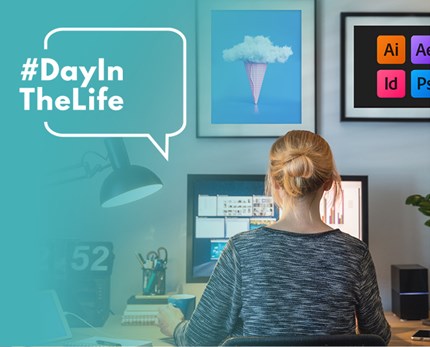Unlocking creative synergy: Effective collaboration between copywriters and designers

- 08 September 2023
Copywriters and designers are two key members of the marketing team. They work together to create the content that will ultimately reach and persuade consumers. However, copywriters and designers often have different skill sets and perspectives, which can lead to misunderstandings and conflict. This article will explore the key factors that contribute to a successful partnership.
What do copy and design have in common with fish and chips, Han Solo and Chewbacca, a cuppa and a good book? They need each other.
When chosen carefully, words and phrases can ignite emotions, sway opinions and spur action. The same applies to good design, but when they work in harmony, well, *chef's kiss*.
However, as a copywriter, I'd be lying if I said I saw eye to eye with every designer I've worked with. Copywriters and designers often have very different skill sets and perspectives, which can sometimes cause disagreements. However, like any relationship, there are steps you can take to help minimise clashes and ensure things run smoothly.
How copy and design work together
Copywriting and design are sometimes viewed as two completely different entities. The copywriter provides the text while the designer creates the visuals. This might be the case when a client outsources a project to freelancers, meaning the designer and copywriter may never even meet. Yet, while it is possible to work like this, we can achieve so much more through collaboration.
Take a new website project, for example. Gone are the days when you could simply upload your text to a basic template and leave it ticking over. A brand's website is more than just a platform for conveying information; it's a narrative. It tells a story by communicating different things at different points to the visitor and takes them on a journey. That's what achieves the primary objective every brand strives for: connection. And, while the copy tells the story, the right visuals make it shine.

Alan Barker, course director for CIM’s Copywriting Masterclass and Creativity for Copywriters, sees an intimate relationship between words and visuals. “A picture may be worth a thousand words,” he says, “but then – that’s a sentence, isn’t it? The picture has to embody a message, and the only way to articulate a message is as a sentence. So, that conversation – focussing on the message and how the image or graphic embodies it – is crucial.”
Outdoor clothing brand Patagonia is an excellent example of this. Not only does it offer its customers a top-tier retail experience, but as an advocate for sustainability, it's a brand that truly lives up to its values and tells that story through its marketing.
Patagonia's website delivers its story at every touchpoint through clear, straightforward design, stunning visuals, and emotional messaging. Its strategic use of copy and design has built the brand a loyal customer base that’s aligned with its core values. This is a great example of how these two elements can work together to produce something that's not only functional, but also emotionally engaging and meaningful.
So, do we think Patagonia achieved that by keeping its copywriters and designers separate? Of course not! Collaboration is how we create magic in marketing.
Eight tips to help copywriters and designers collaborate better
Whether you're a copywriter or designer, you want to be working with your counterpart from the get-go, not against them. Here are some tips to make that happen.
1. Discuss the brief
Meet with your project partner before any actual work occurs to discuss the brief. While this may not always be possible (sometimes a copywriter might be brought in after a template has been created), copy and graphic design work best in tandem.
When a template already exists and the copy is an afterthought, the writer is often left trying to cram in or bulk out content in places where it should and shouldn't be, which potential customers can spot from a mile off.
2. Keep communicating
Communication should continue throughout the project, even after the initial meeting.
Change is inevitable when it comes to marketing projects. Whether a client changes their mind about something or you encounter a technical hiccup, copywriters and designers must be ready to adapt along the way, which is why ongoing communication is needed.
Platforms like Slack have become popular recently and help keep information clear and visible, ensuring nothing is missed.
Don't be afraid to question, clarify, and make suggestions. Open communication and constructive criticism will only prevent misunderstandings and produce better results.
3. Be open-minded
While designers and copywriters are both in the creative niche, they may have different views towards accomplishing goals. Therefore, wiggle room is needed on both sides to complete the project.
Furthermore, when it comes to copywriting, no matter how many times you've reviewed and edited your text in a Word document, you're likely going to have to change some of it once the designer has laid it out.
It can be hard to estimate how much or how little copy you need when writing, so be open to tweaking that as well.
4. Set deadlines
We already covered the importance of communication, and setting deadlines is part of that. Providing updates on where you both are in the project and setting deadlines for certain tasks and overall completion prevents miscommunication, keeps things organised, and ensures everyone is working towards one shared goal.
5. Be honest
Professional copywriters and designers recognise the importance of providing and receiving honest feedback. Even the most experienced benefit from constructive feedback. Not only will it improve the project's outcome, but it also helps both parties to develop their own skills.
6. Learn some fundamental design principles
If you're a copywriter, it helps to know at least a few fundamental design principles. Things like white space, balance and alignment will help you write sounder copy and work better with the designer.
Alan Barker agrees. “Gaining insights into visual design can improve your copywriting no end. It’s all about rhythm, contrast, emphasis. If you think about the shape of a sentence, you’ll create copy that shines as much as the visuals that accompany it.”
Understanding the design process will also help you optimise the project timeline.
7. Don't give creative freedom to change copy
Now and again, you'll come across a designer who thinks it's okay to tweak the copy themselves to make a header fit or an image pop. While they aren't doing this with bad intentions, it's a problem. They probably don't realise how much time and effort you've spent choosing every word. So, if that's the case, it's worthwhile asking them to involve you in any text changes (and try not to make them wait, as they’ll be less willing to do so).
8. Always refer back to the brief
Last but not least, always refer back to the brief. As creatives, getting swept up in the excitement of a new idea happens often. I've made that mistake, only to be reviewing the final draft and realising I've forgotten a key objective.
There's a simple way to avoid that: bullet point the key objectives and include them at the top of the page you're writing on. Yes, it's shamefully simple, but it's an easy way to keep referring back to them. Alternatively, a sticky note in the corner of the computer works. Not only will it keep you both on track, but it can also help when it comes to approaching any disagreements that may arise around creative perspectives.
Final thoughts
In today's competitive landscape, where consumers are susceptible to information overload, the need for exceptional collaboration between copywriters and designers cannot be overstated. When combined, each party's unique skill sets and perspectives can produce remarkable content that stands out, effectively communicates messages, and ultimately drives results for businesses.
So, copywriters, be the Han Solo to your designer's Chewbacca, and vice versa. Together, you can create a powerful synergy that benefits each other, the team, and, most importantly, delivers the best outcome.
Learn how to cultivate your creativity and streamline your copywriting process with our Creativity for Copywriters training course.

- 0 views





